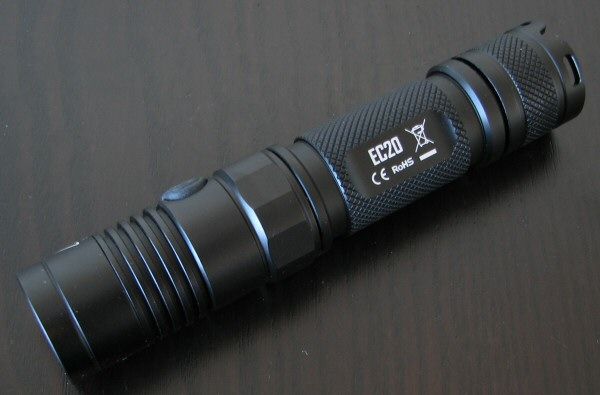
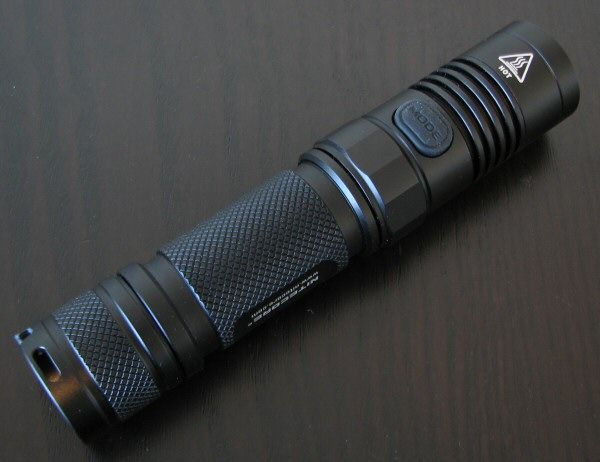
Following on the earlier 1x18650/2xCR123A models from Nitecore – the P12 and P10 – I have on hand for this review the new EC20. The EC20 uses a similar side-switch as the P12 for mode changing, but lacks the physical clicky switch of that model.
Let's see how it compares to the other recent offerings from Nitecore – and from other makers.
Manufacturer Reported Specifications:
(note: as always, these are simply what the manufacturer provides – scroll down to see my actual testing results).
- LED: CREE XM-L2 T6 LED
- Maximum output of up to 960 lumens
- Output/Runtime (2600mAh 18650): Hi 960 lumens / 1hr15min – Med 210 lumens / 6hr – Lo 50 lumens / 28hr – Lower 1 lumen / 520 hr
- Integrated "Precision Digital Optics Technology" provides extreme reflector performance
- Boasts a peak beam intensity of 12,450 cd and a throw distance of up to 222 meters
- Innovative single button offers access to seven brightness levels and modes.
- High efficiency constant current circuit board provides max runtime of 520 hours.
- Integrated power indicator light displays remaining battery power (patented)
- Power indicator's secondary function displays battery voltage (accurate to 0.1V)
- Instant access to ultra-low output
- Reverse polarity protection prevents damage from incorrectly inserted batteries
- Constructed from aero grade aluminum alloy with HAIII military grade hard-anodized finish
- Waterproof in accordance to IPX-8 (two meters submersible)
- Impact resistant to 1.5 meters
- Tail stand capability
- Dimensions: Length: 128mm (5"), Head diameter: 25.4mm (1"), Tube diameter: 25.4mm (1")
- Weight: 76g (2.68oz)(without battery)
- Package Details: 1. 1 x Nitecore EC20 Black Flashlight, 2. 1 x Quality Lanyard and Spare O-ring
- MSRP: ~$45
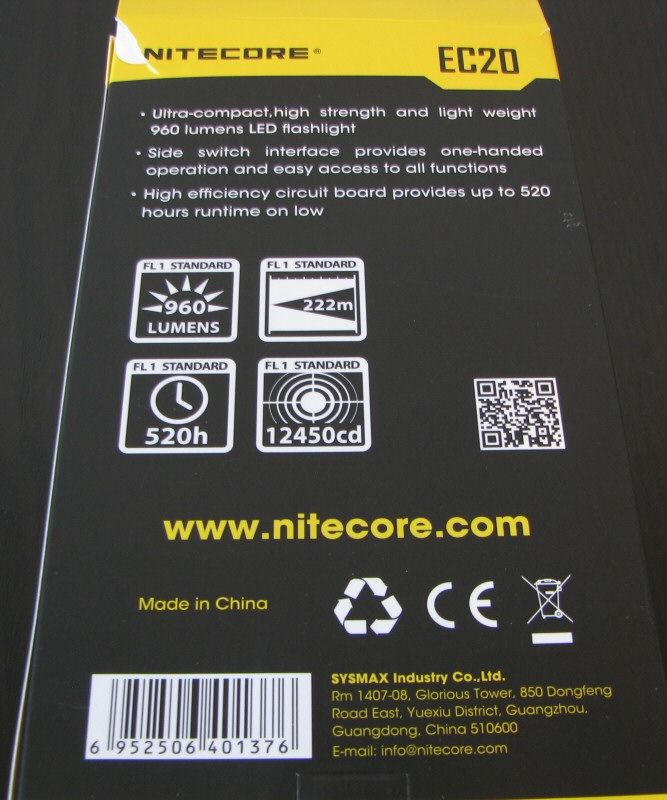
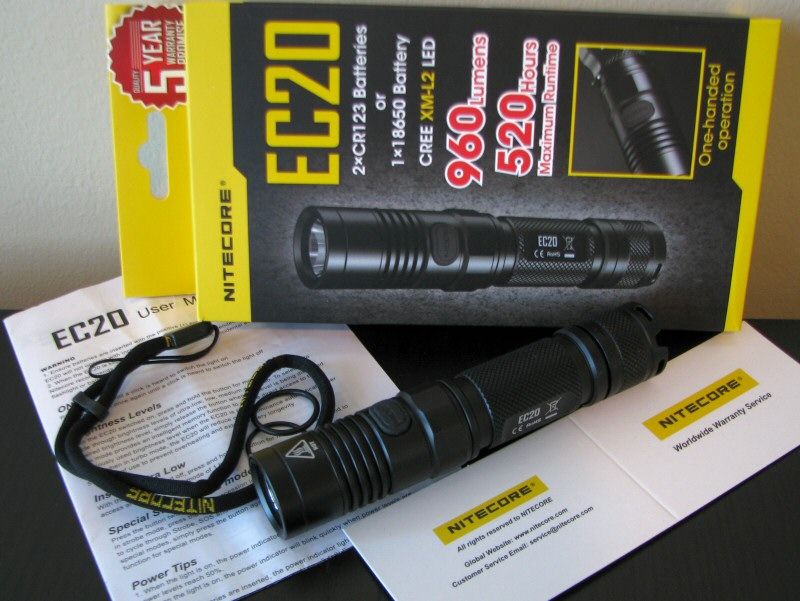
Packaging is Nitecore's standard thin cardboard display box, with specs and information printed right on the box. In keeping with the lower price, the bundled accessories are bit sparse. Included with the light are spare O-rings, basic wrist lanyard, warranty card, and manual. Not included on this model are things like the removable grip ring, pocket clip, and holster with Velcro closing flap (which are found on the P12).
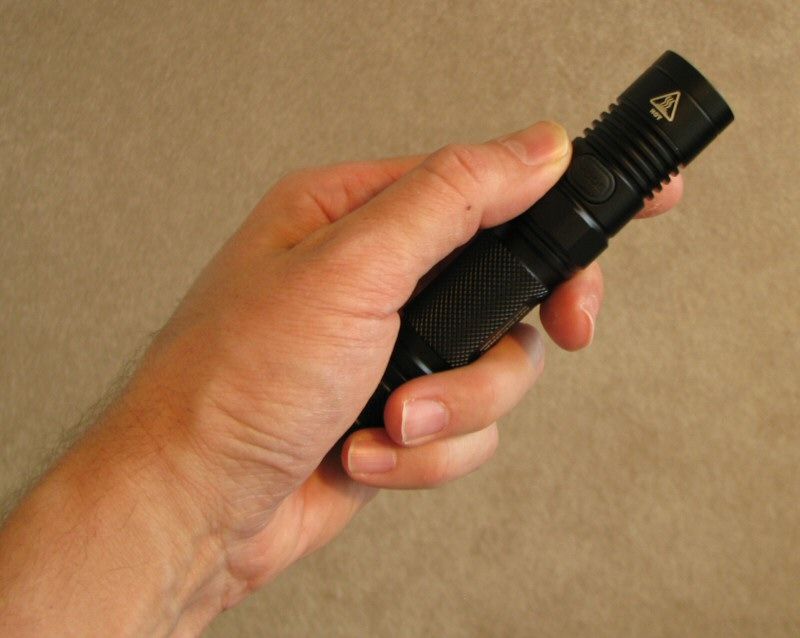
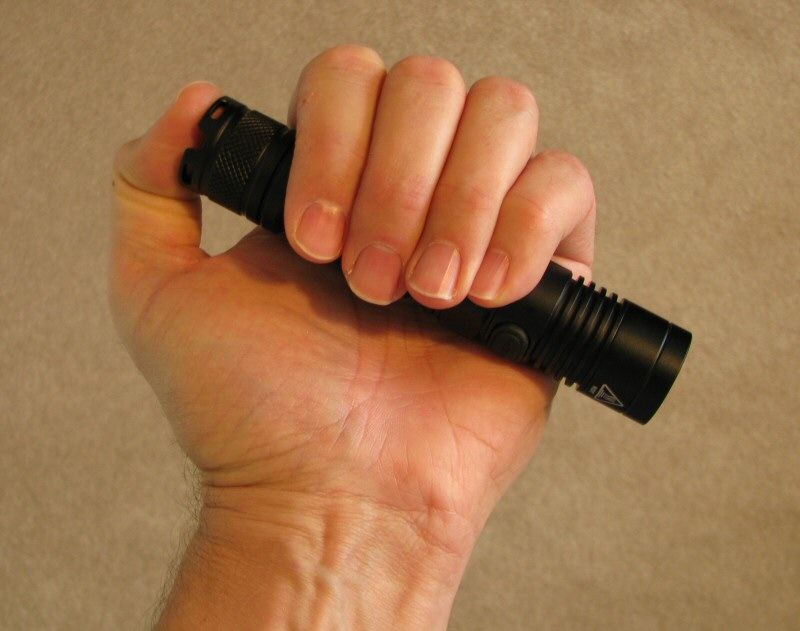
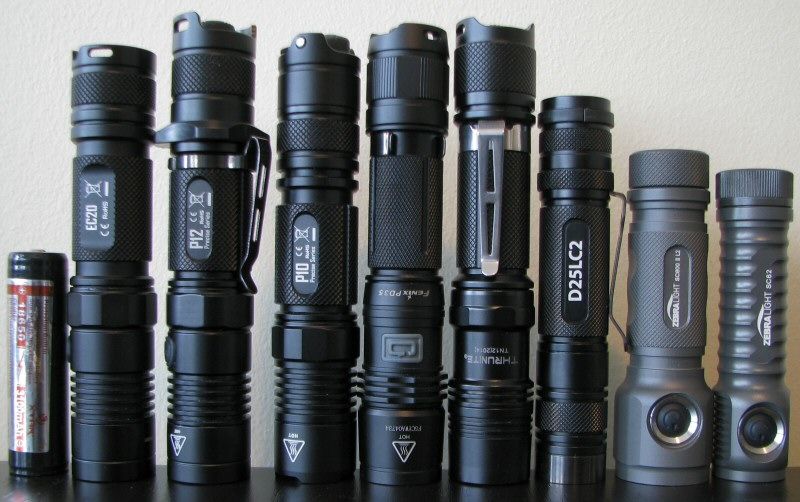
From left to right: Xtar Protected 18650 3100mAh; Nitecore EC20, P12, P10; Fenix PD35; Thrunite TN12-2014; Eagletac D25LC2; Zebralight SC600-II, SC62.
All dimensions directly measured, and given with no batteries installed:
Nitecore EC20: Weight: 77.1g, Length: 129.2mm, Width (bezel): 25.4mm
Nitecore P10: Weight 82.0g, Length: 135.1mm, Width (bezel): 25.5mm
Nitecore P12: Weight: 89.7g, Length: 139.4mm, Width (bezel): 25.4mm
Eagletac D25LC2: Weight: 50.0g, Length: 116.3mm, Width (bezel): 22.5mm
Eagletac TX25C2: Weight 93.6g, Length: 120.4mm, Width (bezel): 31.6mm
Fenix PD35: Weight: 82.7g, Length: 138.1mm, Width (bezel): 25.4mm
Olight S20 (2013, XM-L2): Weight: 52.4g, Length: 106.5mm, Width (bezel): 23.1mm
Skilhunt DS20: Weight: 53.8g, Length: 110.0mm, Width (bezel): 24.0mm
Sunwayman C20C: Weight 57.6g, Length: 104.8mm. Width (bezel): 25.6mm
Thrunite TN12-2014: Weight: 80.0g, Length: 140.5mm, Width (bezel): 25.4mm
Zebralight SC600 II: Weight 79.3g, Length: 101.8mm, Width (bezel) 29.7mm
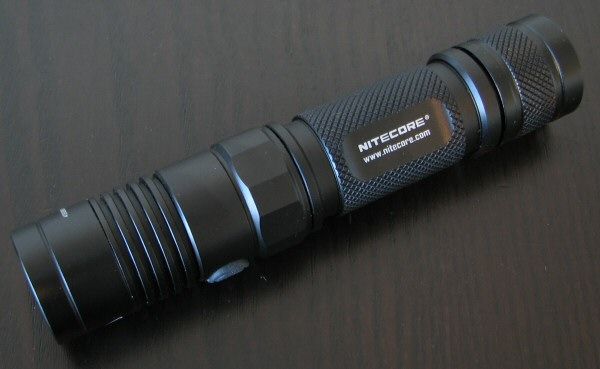
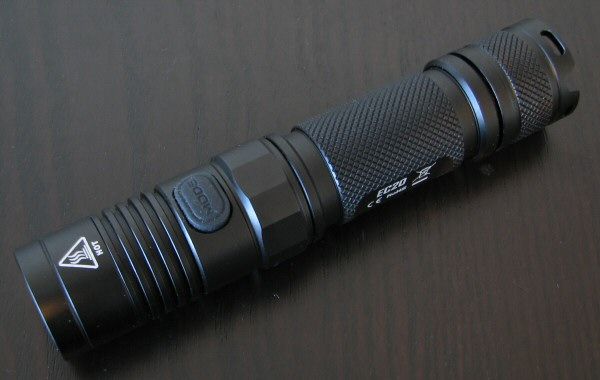
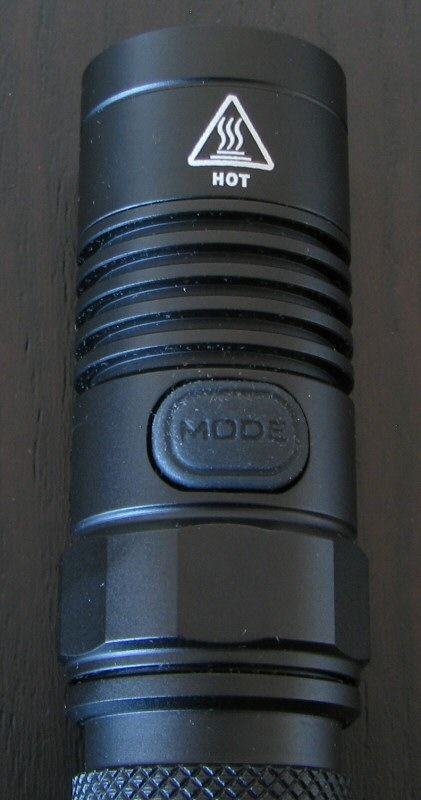
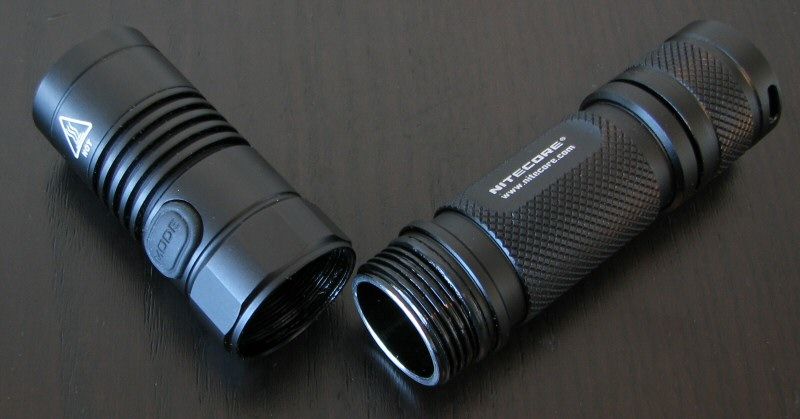
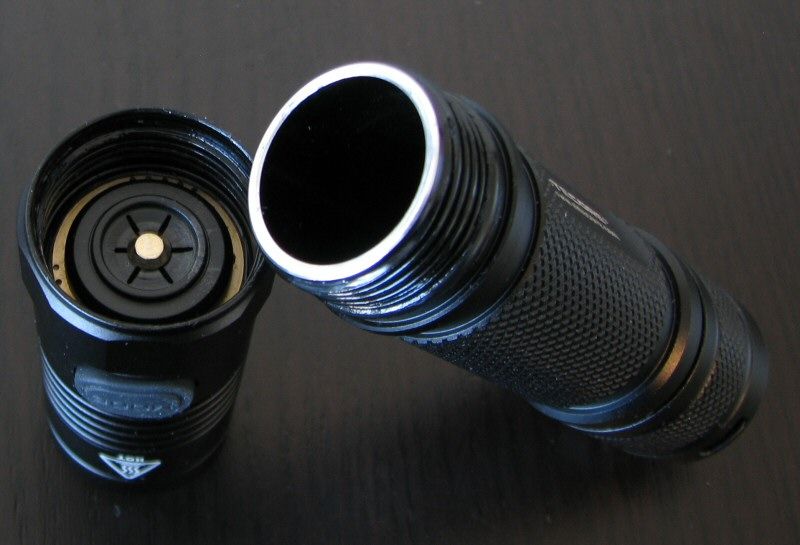
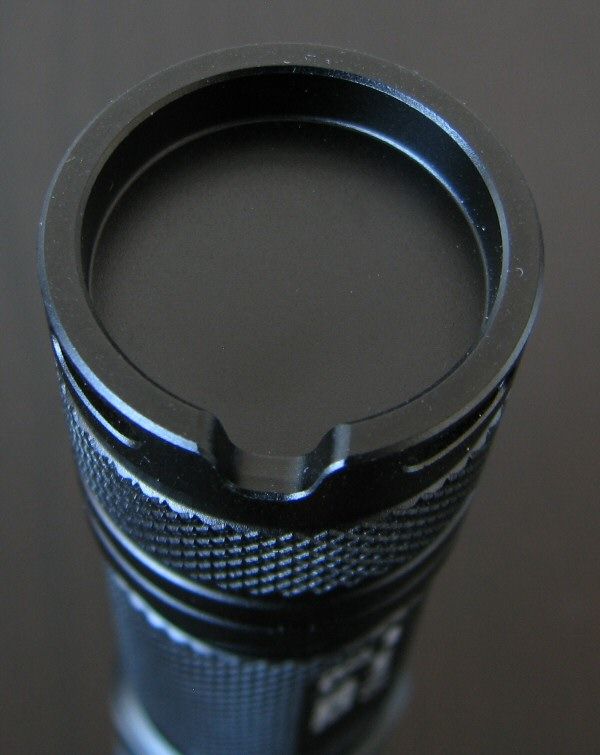
The EC20 is a compact light – basically, it looks a lot like the P12 but with a short flat tailcap instead of the larger tailcap clicky. Body styling is almost identical – the only difference I noted was the extended ridge on the EC20 to allow you to reverse the position of a pocket clip. Odd that they don't seem to include a clip by default with this light. :shrug:
As with the P12, anodizing is a shiny black finish, hard anodized, with no chips or damage on my sample. Body labels are bright white and clear against the black background. Knurling is of moderate aggressiveness on the body tube and tailcap. But when combined all the other grip elements (e.g., side switch cover, fins in the head, pocket clip, etc.), I would describe overall grip as pretty good.
The light has some anti-roll indentations on the body, but they are not very effective (i.e., a pocket clip or grip ring would help).
Tailcap screw threads are standard triangular cut and anodized for lock-out at either end of the body tube. Tailstanding is stable due to the flat tailcap. Tailcap is suitable for lanyard attachement, while still allowing tailstanding
On/off and mode switching is controlled by a single electronic switch in the head. The switch has a standard feel for an electronic switch, with typical traverse. It is relatively easy to locate by feel (although could be more distinctive visually).
Like the P12 model, there is a blue LED under the switch that will glow blue when the batteries are running low. It also serves as a voltage read-out function. Please see my User Interface section for a discussion.
There is a physical reverse polarity feature in the head. However, this has been updated from earlier Nitecore models and now allows "wide button top" cells to work in the light. True flat-tops (where the positive contact is below the wrapper) won't work, but all my cells with a slightly raised contact worked fine.
The body tube is wide enough to accommodate all size 18650 cells, and there seems to be plenty of room of longer cells as well.
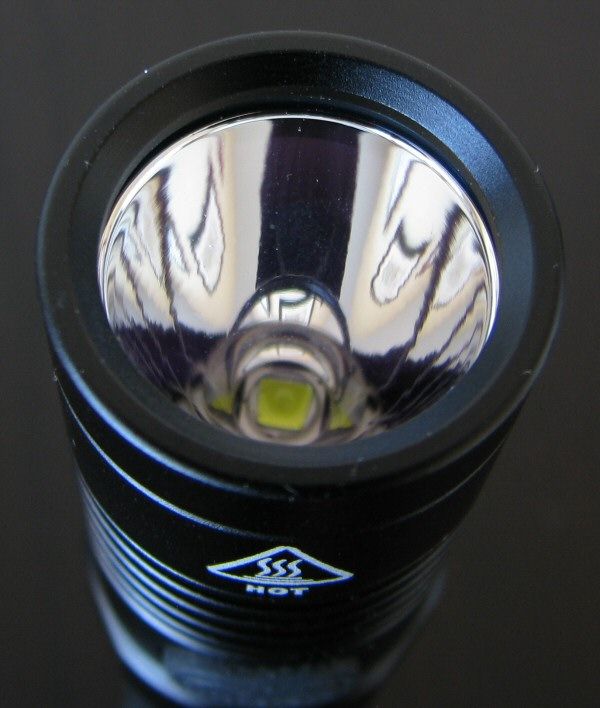
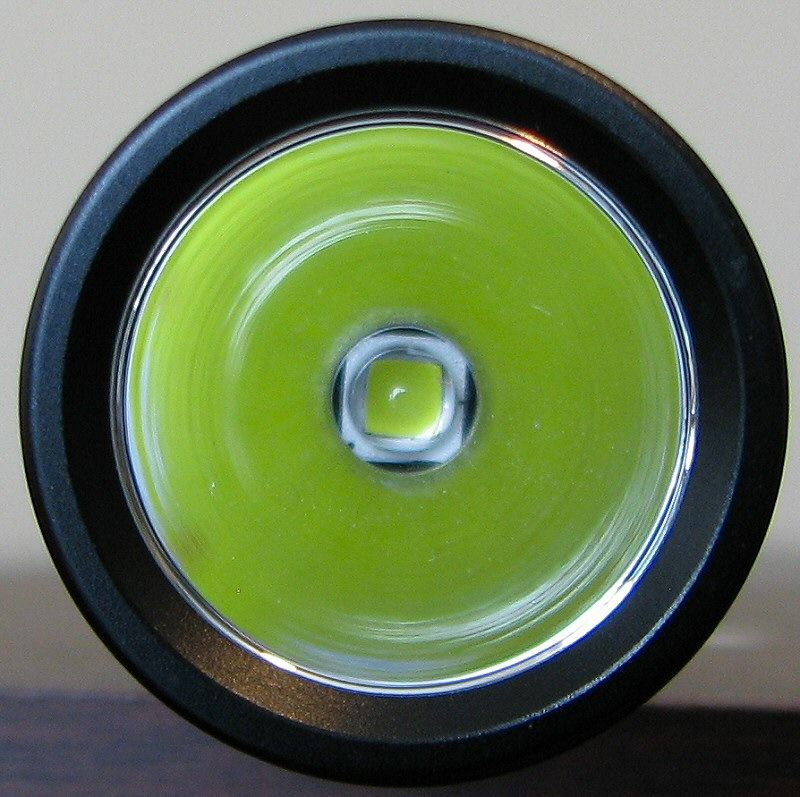
The EC20 comes with a flat black aluminum bezel. The overall head is typical for this class - not very large – and looks the same as the P12. Reflector is smooth, and fairly deep given this size head. Coupled with the XM-L2 cool white emitter (which was well centered on my sample), I would expect a fairly typical beam pattern, but with slightly greater throw than many in this class. Scroll down for beamshots.
User Interface
The EC20 uses a single electronic switch interface. Fully tighten the tailcap to allow the light to function.
Turn the light on/off by a click of the side switch.
To change modes, press and hold the switch (while the light is on). Mode sequence is Lower > Lo > Med > Hi, in repeating sequence. The light has mode memory, and returns the last level set after turning the light off/on.
Double click the switch (from either on or off) to access the blinking modes. Press and hold to advance through all the strobe modes. Mode sequence is: Strobe > Locator Beacon > SOS, in a repeating loop. A single click exits you from the blinking modes and turns off the light. Note that there is no mode memory for any of the blinking modes.
Like the P12, the EC20 also has a blue LED under the switch to serve as a low voltage indicator when the flashlight is on. Once the cells are below 50% power (according to Nitecore), this indicator will flash blue every 2 seconds. It will flash faster as the power capacity drops down further.
Note that when first inserting connecting the light, the blue LED under the switch will read out the voltage of the battery in a series of flashes (e.g., four flashes, followed by a short pause, with two more flashes would indicate a full charge of 4.2V).
Video:
For information on the light, including the build and user interface, please see my video overview:
As with all my videos, I recommend you have annotations turned on. I commonly update the commentary with additional information or clarifications before publicly releasing the video.
PWM/Strobe
The EC20 appears to be current-controlled. While there is no pulse width modulation (PWM) as such, there are faint re-occurring signals on the Lo/Med modes - but not the Lower or Hi modes.
Lower:
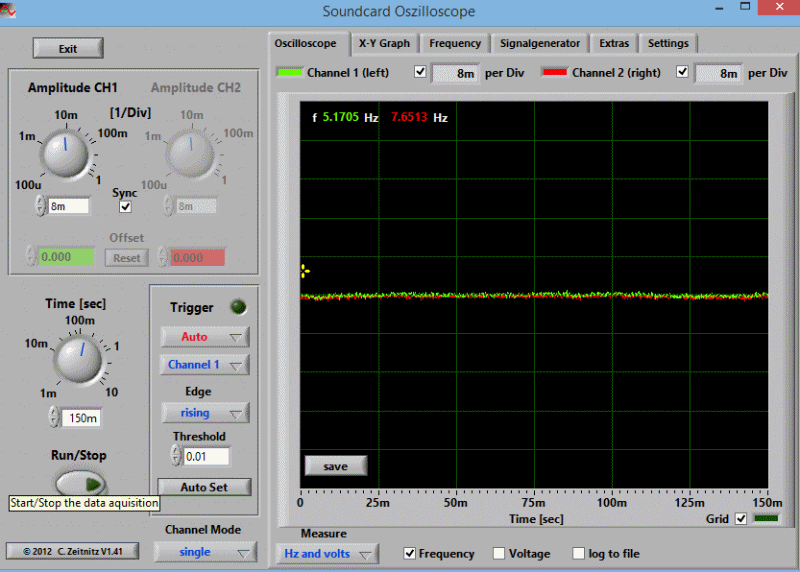
Lo:
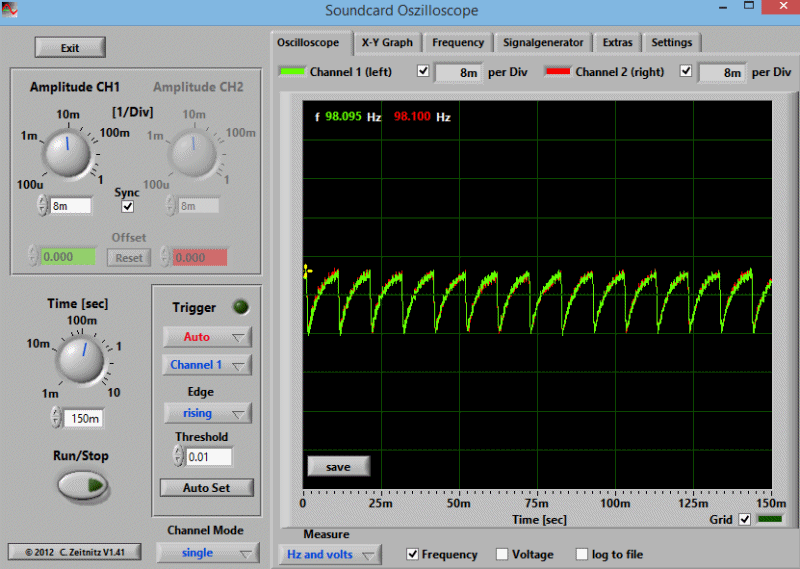
Med:
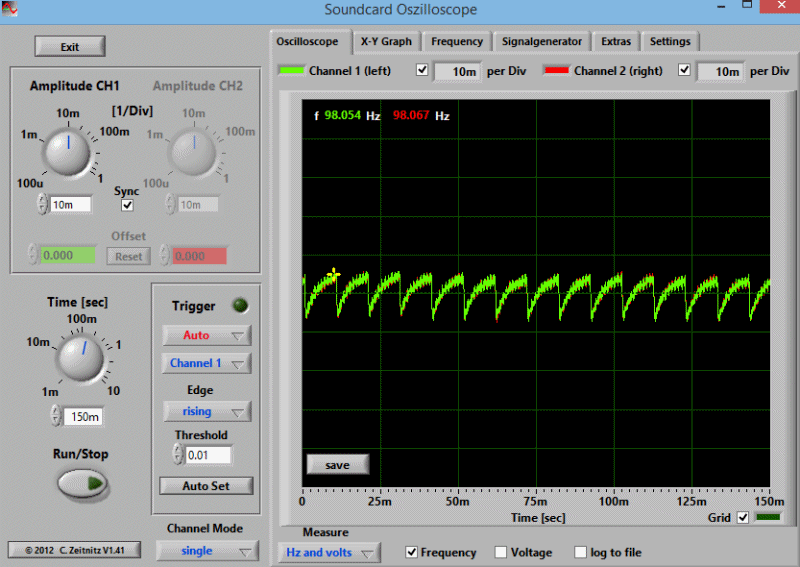
Hi:
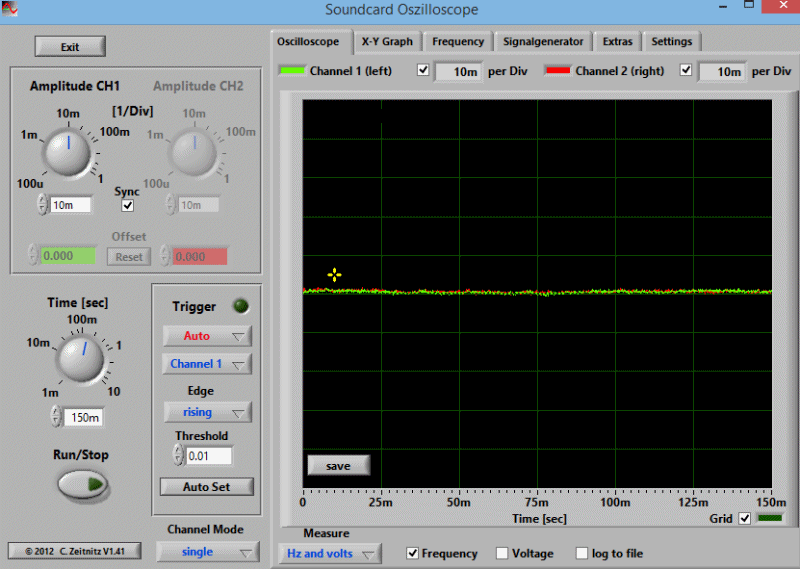
As you can see, there is a circuit pattern on Lo and Med only, around 98 Hz. There are secondary patterns detectable at higher frequency, as shown below for Med on a different time scale:
Med
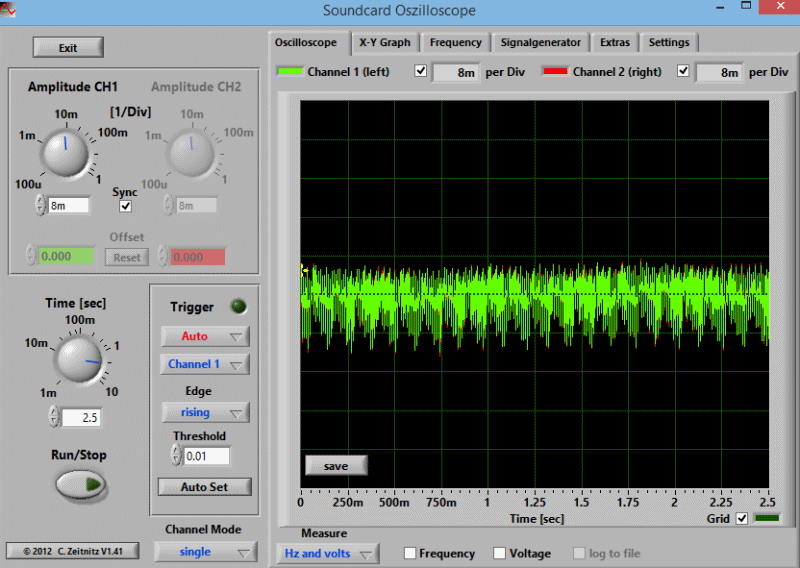
Again, consistent with my standard review policy, I report on any oscilloscope signals that I can detect in the output of a light. But I can assure you that the above patterns produce no visible effect – even when shining on a fan. Like P12 – which had a very similar pattern – the EC20 is fully "flicker-free" at all levels.
Strobe
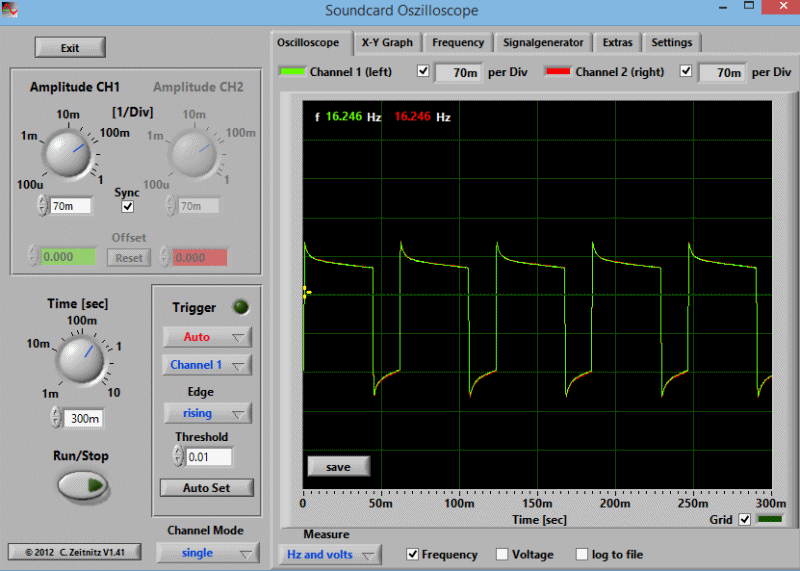
The strobe was a very fast "tactical" strobe, of 16.3Hz frequency. Strobe duty cycle is a little unusual, as it is only "on" a portion of the total time of each strobe cycle. Most strobes are an even 50:50 on/off, but the EC20 is strobe mode like 25:75 on/off, as shown below
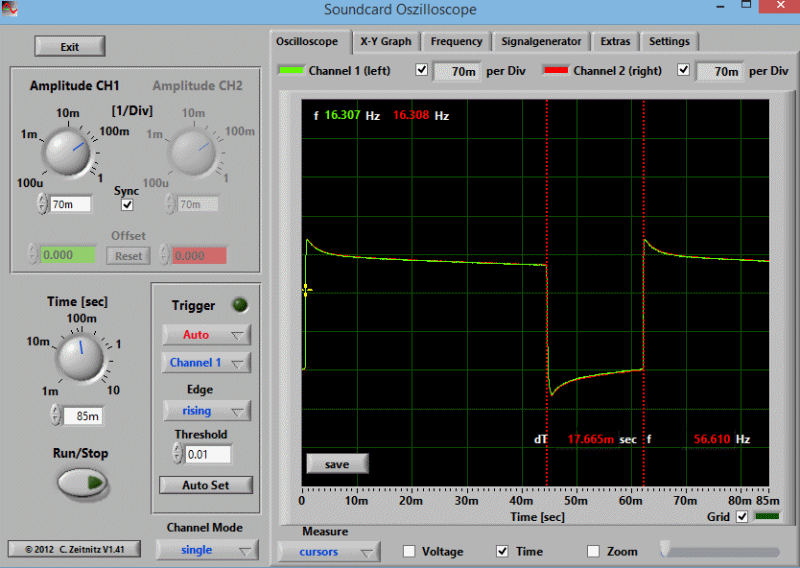
I observed something very similar on the P12 – it seems like the EC20 has basically the same circuit.
Beacon/Location
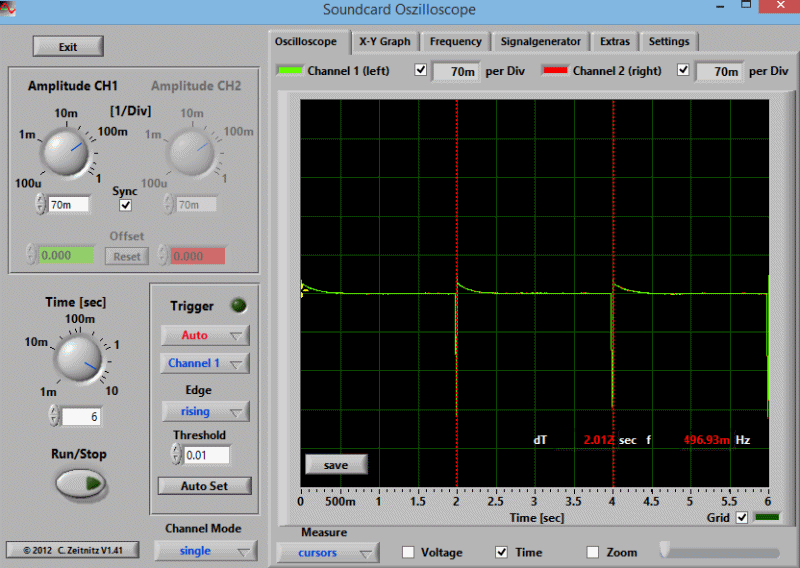
Beacon was a quick high-output flash, once every 2.0 secs or so.
SOS
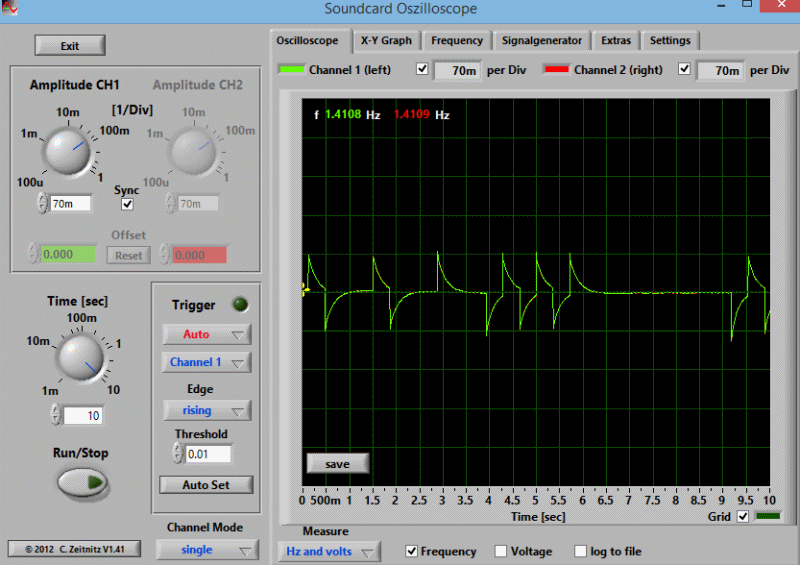
SOS was a fairly typical SOS mode.
Standby Drain
Since the EC20 uses an electronic switch, there needs to be a standby current when the tailcap is connected.
When first connecting a battery, the circuit will read out the battery voltage as a series of flashes of the blue LED under the switch. Current during this time can be as high as 3.3mA. Once the readout is finished however, current drops to a consistent 124uA standby drain. For a 3100mAh 18650, would mean it would be fully drained in a little under 3 years. Not really much of a concern there.
Accidental activation can be prevented by a physical lock out of the light – simply do a quick turn of the tailcap (or head) when not in use.
Beamshots:
For white-wall beamshots below, all lights are on Max output on an AW protected 18650 battery. Lights are about ~0.75 meter from a white wall (with the camera ~1.25 meters back from the wall). Automatic white balance on the camera, to minimize tint differences.
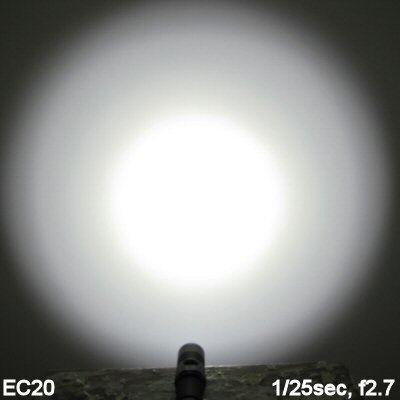
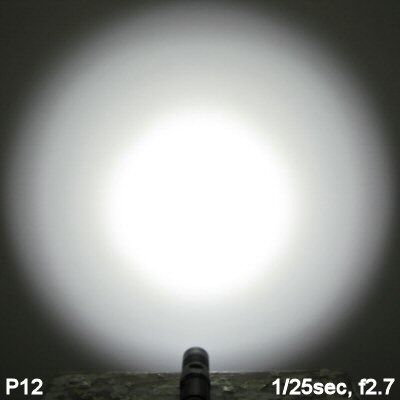
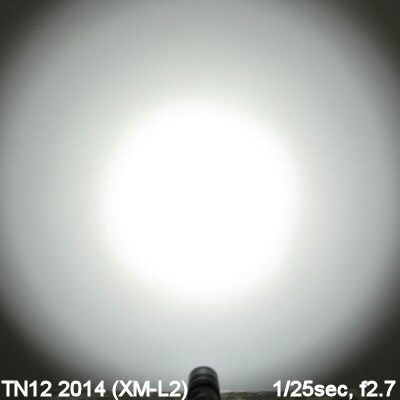
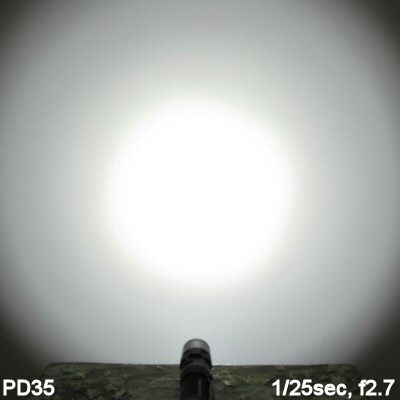
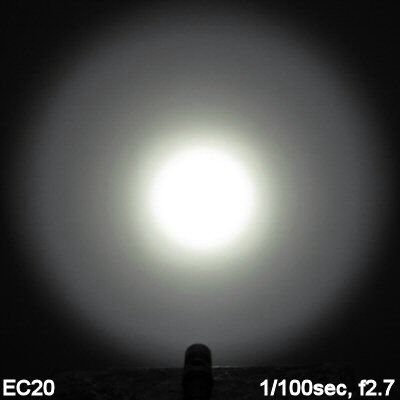
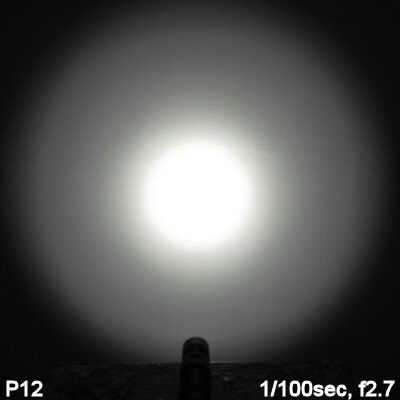
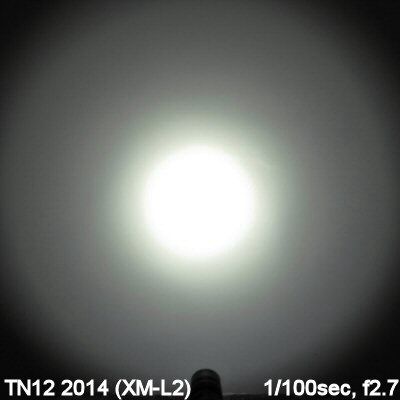
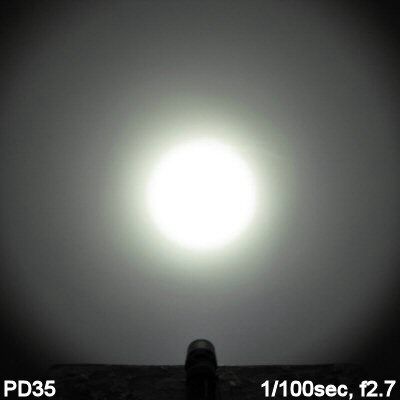
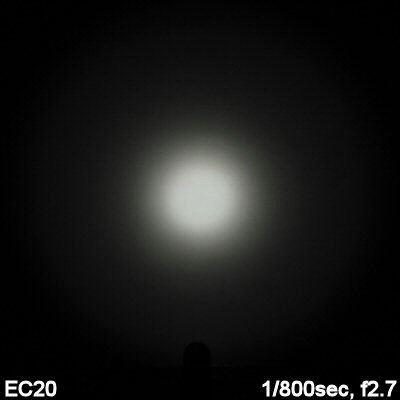
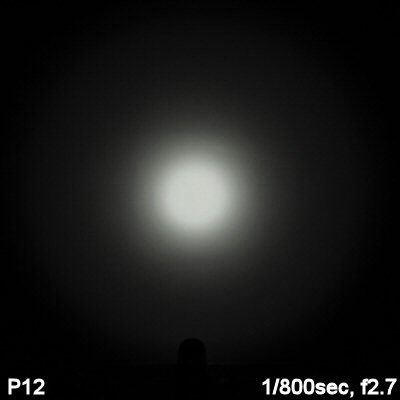
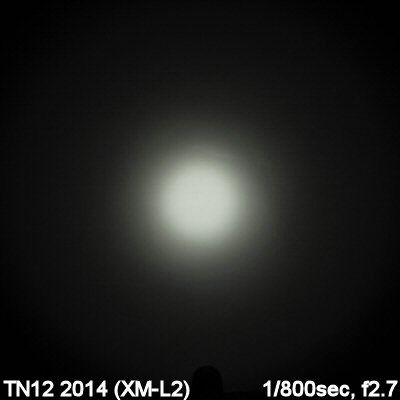
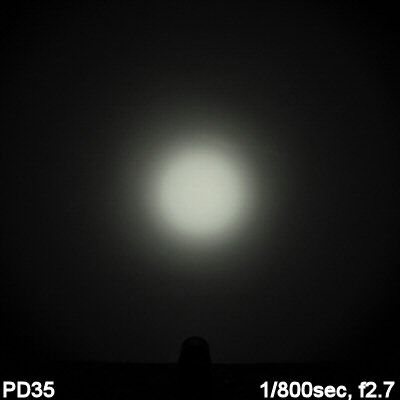
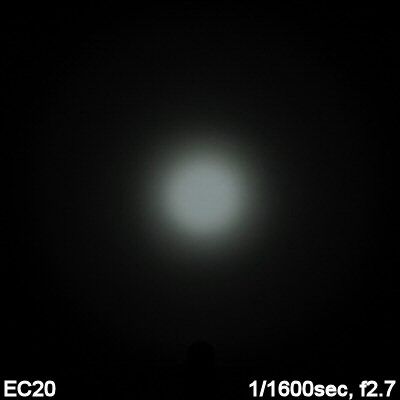
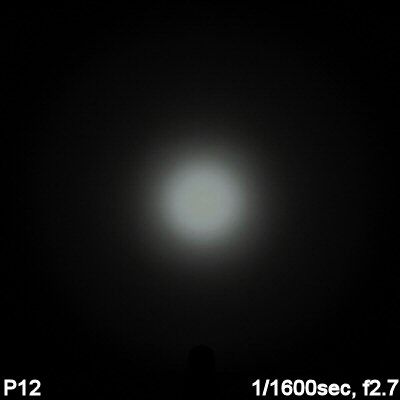
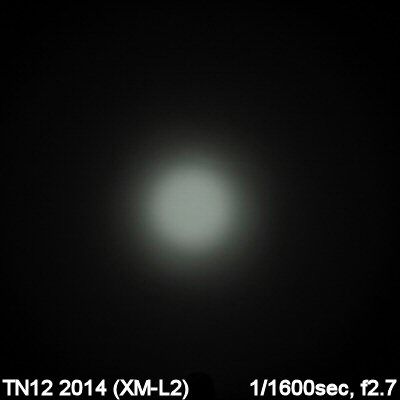
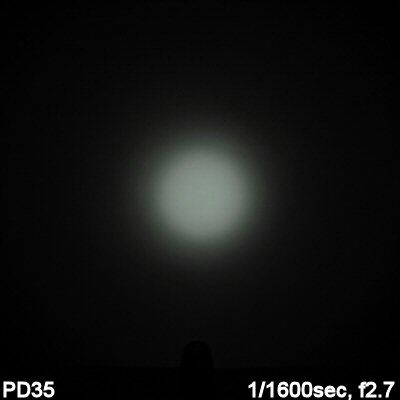
Beam pattern is consistent with the P12 (and about what you would expect for a light this size). Spillbeam width is slightly narrower than some recent competitors, and the EC20/P12 have excellent throw for the class. Scroll down for detailed output and throw measures.
Testing Method:
All my output numbers are relative for my home-made light box setup, as described on my flashlightreviews.ca website. You can directly compare all my relative output values from different reviews - i.e. an output value of "10" in one graph is the same as "10" in another. All runtimes are done under a cooling fan, except for any extended run Lo/Min modes (i.e. >12 hours) which are done without cooling.
I have devised a method for converting my lightbox relative output values (ROV) to estimated Lumens. See my How to convert Selfbuilt's Lightbox values to Lumens thread for more info.
Throw/Output Summary Chart:
My summary tables are reported in a manner consistent with the ANSI FL-1 standard for flashlight testing. Please see http://www.flashlightreviews.ca/FL1.htm for a discussion, and a description of all the terms used in these tables. Effective July 2012, I have updated all my Peak Intensity/Beam Distance measures with a NIST-certified Extech EA31 lightmeter (orange highlights).
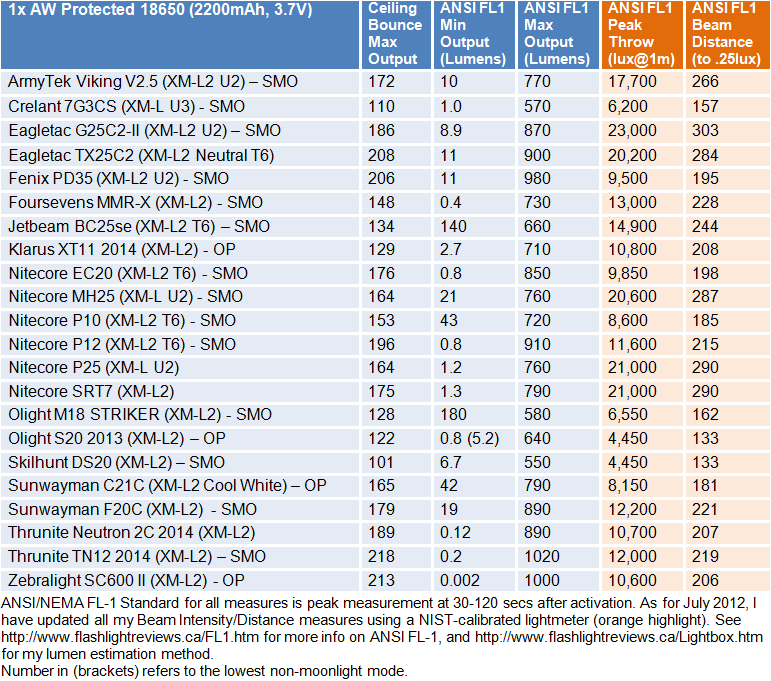
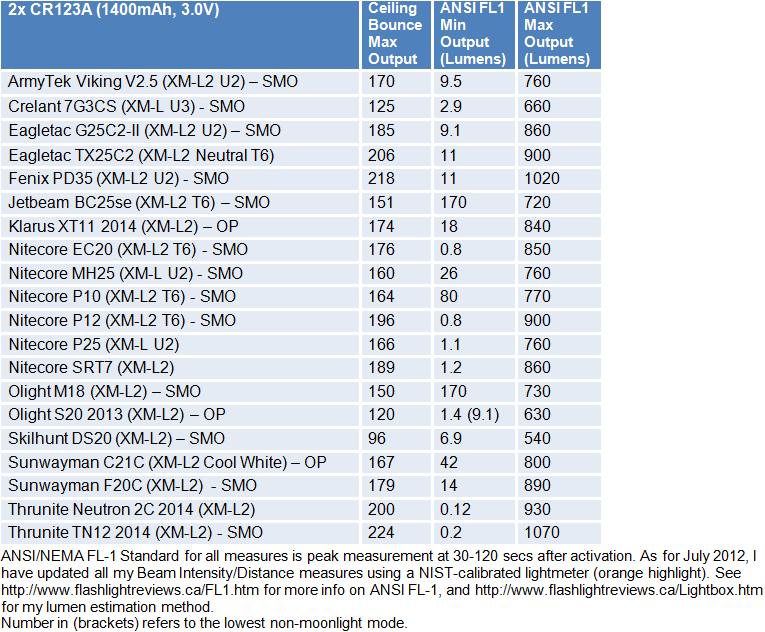
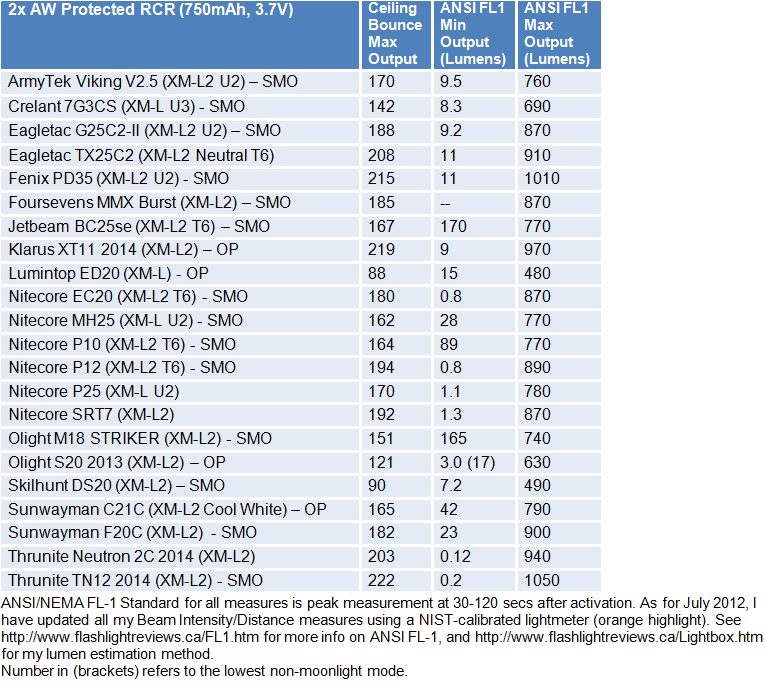
Max output of the EC20 is a little lower than my P12. Basically, the EC20 seems intermediate to the P10 and P12. Due to the common head, throw is similarly intermediate to these two lights. Minimum output is very consistent with the P12.
Let's see how all the levels compare across the P12, P10 and EC20 in my lightbox:
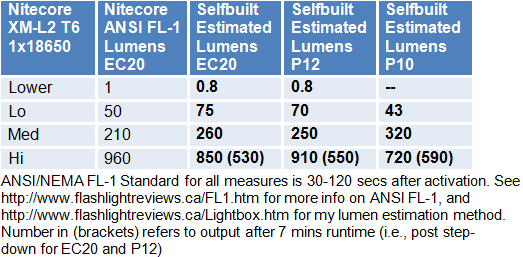
These results appear to suggest that the P12 and EC20 are pretty much equivalent in number of type of modes. There is just a slight output advantage to my P12 initially.
Although I am only showing the first timed step-down on Hi above, both the EC20 and P12 have a second timed step-down (at ~41-42 mins into the runs). But the EC20 differs from the P12 in terms of final output after this second step-down: it is ~340 estimated lumens on the EC20, versus ~250 estimated lumens on my P12 sample.
As before, I am glad to see the <1 lumen "Lower" mode on the EC20, as I personally like having low-level options in a general purpose light. This is very helpful when you have dark adapted eyes.
Output/Runtime Graphs:
I have been testing a variety of brands of protected NCR18650A (3100mAh capacity) batteries for some time, to see if I can provide runtime comparisons that are more relevant to today's commonly used cells. This is not as easy as it may sound, since not all brands will fit in all lights (unlike the 2200mAh AW cells). But I have found a range of brands that show good correlations and internal consistency. As such, I will now start focusing on 3100mAh runtimes in my reviews. :wave:
To start, here is a comparison of some recent lights on 3100mAh cells.
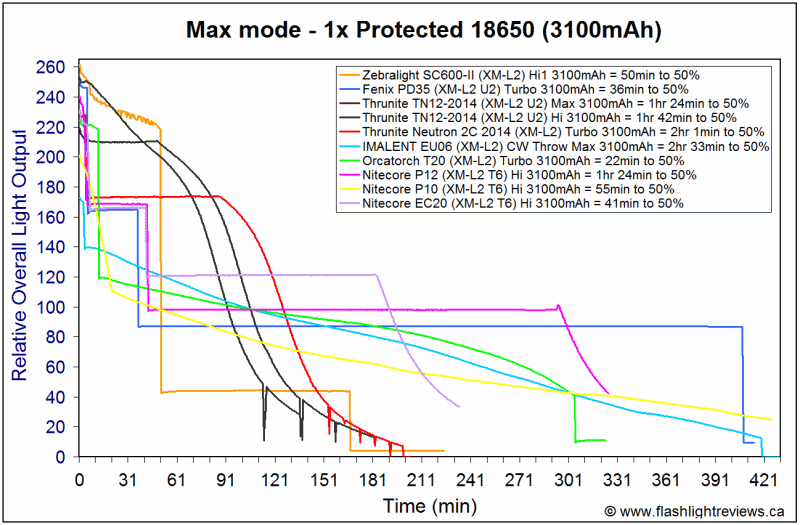
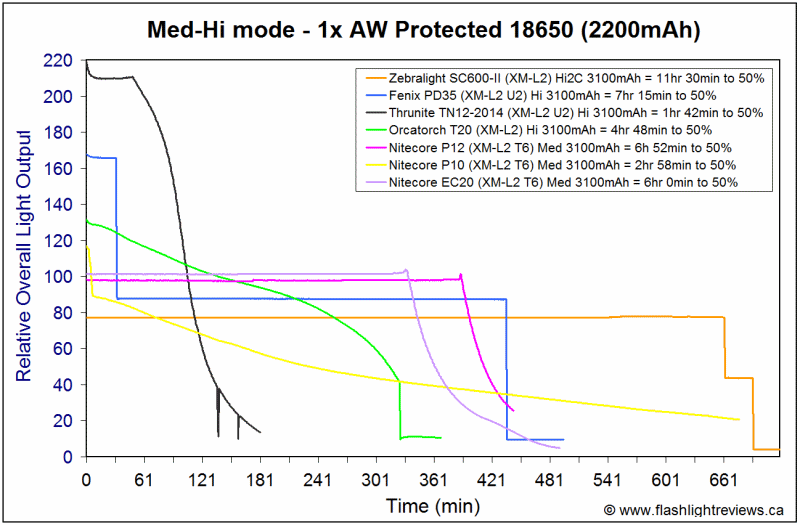
And here are some additional Hi comparisons to older reviews, where I was still using only 2200mAh cells.
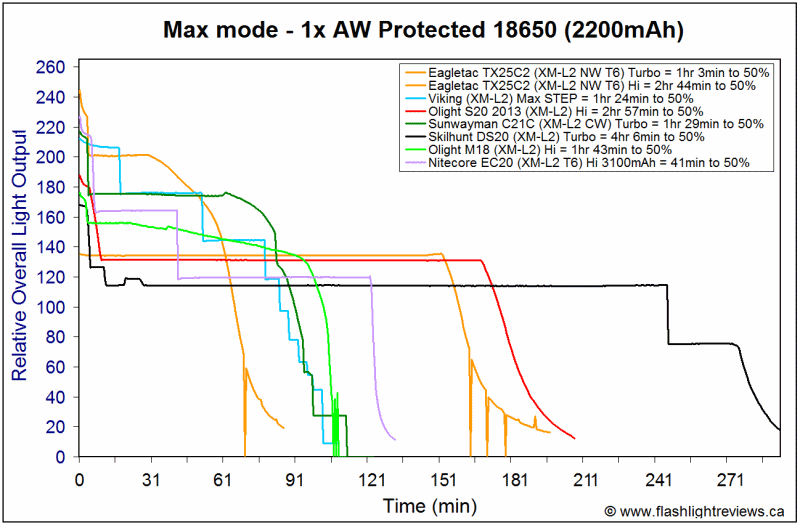
It's hard to see in the graphs, but the timings of the Hi mode step downs are slightly different between the P12 and EC20. The P12 starts its first step down from Hi at ~4 mins, and takes ~1.5 mins to reach its first defined step-down output level. The EC20 starts its first step down ~5 mins (and similarly takes ~1.5 mins to reach its new steady-state). Similarly, the second step-down from Hi is delayed by a minute (i.e., ~42 mins on the EC20 from start, compared to ~41 mins on the P12).
But the real difference is that the second step-down takes you to a higher level on the EC20 (i.e., ~340 lumens, compared to ~250 lumens on the P12). This means that total extended runtime will be less on the EC20, compared to the P12.
Otherwise, you could consider the EC20 and P12 as roughly equivalent. These lights show very good efficiency and regulation at all levels. As I mentioned in my P12 review, I would personally like to see the first step down from Hi be available as a fifth mode (i.e., sort of Med-Hi mode).
And now runtimes on 2xRCR and 2xCR123A
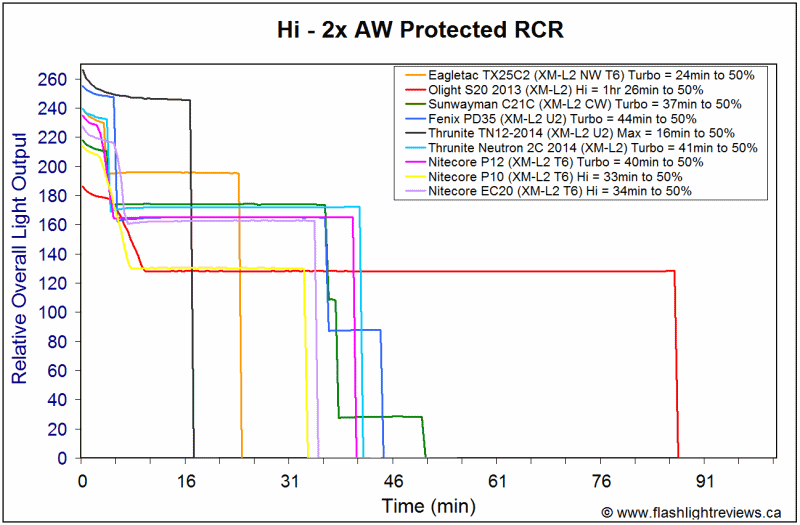
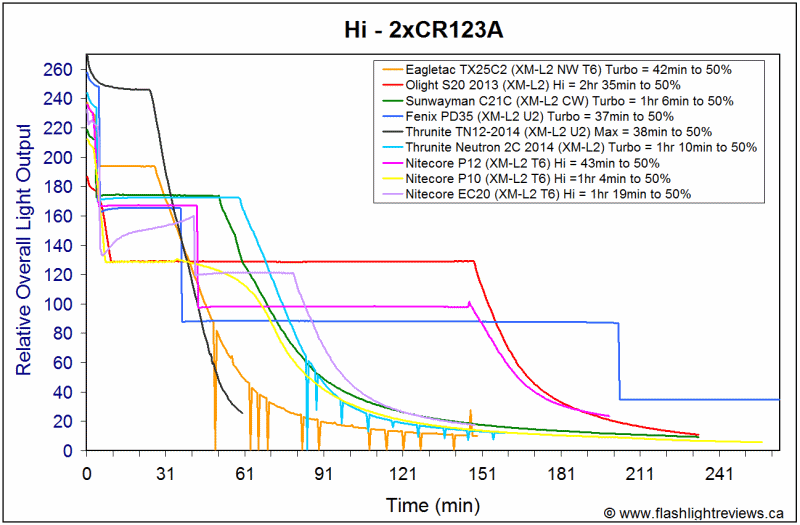
The effect of the slightly delayed initial step-down from Hi on the EC20 has a consequence on my 2xCR123A runtime above. The unusual pattern you see above is presumably due to PTC engagement right at the start of the first timed step-down. I have seen this before on a number of lights – the made-in-the-USA CR123As that I use tend to have their thermal safety features set lower than cells manufactured elsewhere. For a detailed discussion of this phenomenon, please see all the comments in this thread. It is unlikely to be an issue for most users.
Potential Issues
There are a couple of timed step-downs from Hi on the EC20, similar to the P12 (although with a less pronounced final step).
Like the P12, I would argue the EC20 lacks a typical "Hi" mode (i.e., the initial EC20/P12 "Hi" mode is basically Turbo, with no lower Med-Hi mode as found on most lights). I would think adding the first step-down Hi level into the regular sequence would be a good idea (i.e. as a fifth selectable mode).
On the EC20 Hi mode, there is a slightly extended time before the first step-down occurs (compared to the P12). As result, this may trigger the built-in battery PTC protection feature on made-in-the-USA brand CR123A cells.
Preliminary Observations
The EC20 is basically the same light as the P12 reviewed previously – only with a revised interface (i.e., no tailcap clicky, and using press-holds instead of clicks to cycle through output levels with the electronic switch). It also has more basic package of accessories (although the P12 accessories will all fit and work here). Otherwise, I would consider the use and feel to be extremely similar between these two models.
In terms of the physical build, overall quality is good as before – with decent hand feel and ergonomics. User interface is appropriate for a single-switch design, with good feel to the switch. As before, the low-voltage and battery read-out features of the LED under the switch are nice additions to this class.
In terms of output modes, the EC20 is again very similar to the P12. The main difference is that the second timed step-down mode from the Hi level is higher on the EC20 than the P12. As before, while there is a good range of constant modes, I would personally have preferred one extra intermediate Med-Hi mode as well (i.e., something like the first Hi step-down level). Please see my original P12 review for general comments on the mode sequence and feature set.
Given that the lights seem to have basically the same circuit, output/runtime efficiency remains very good as before. The light is fully flat-stabilized at all levels.
Beam pattern remains good as well, with a nice balance between throw and spill. Given the fairly standard size head, there are lots of beam shaping accessories out there from a range of makers that will fit on the light.
At the end of the day, it seems to me that the EC20 is basically a "budget" version of the P12. You get essentially the same light features and performance – just without the tailcap clicky switch or extra accessories. If these things don't matter to you, the EC20 is an excellent value for the price – and the P12 is always available as well, if that better matches your preferences. :wave:
-----
EC20 provided by Nitecore for review.



